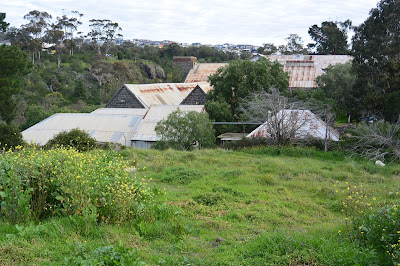 |
| View of the paper mill and the Barwon from the edge of Button Hill |
Firstly, the rags had to be cleaned and this process began with the removal by hand of any attachments such as buttons, fastenings and ribs from women's stays after which the rags were sorted. This work was undertaken by girls and women known as "ragpickers". It was by all accounts, not a pleasant job. An article in the Geelong Advertiser (25th August, 1880) described the work as "anything but clean and in no way agreeable".
Over the years, there were various reports of inquiries into the treatment of and conditions endured by ragpickers. A 1914 inquiry heard that rags for the mill were sourced from a variety of places and came in a variety of qualities. The majority of rags, claimed the mill's representative, came from clean sources; off cuts from drapers, tailors, white workers and shirt factories, however this was a limited supply which was also sought after by "flock-makers" who used the rags to make "flocking" for stuffing saddles, mattresses and other products. This meant that the mill had also to use dirty rags and it was the sorting and cutting of these rags prior to cleaning which concerned the commissioners investigating conditions in 1914 (Geelong Advertiser, 11th February, 1914).
 |
| A woman working in the rag sorting room at the Barwon Paper Mill, 1876-1923. Image taken from the JH Harvey collection, Sate Library of Victoria |
As might be expected with this type of machine in an era before occupational health and safety was a serious concern, there were accidents. And some of them were serious. On 26th September, 1907 the Geelong Advertiser carried an article describing an incident in which "A young woman named Ada Bailey, aged 23...was the victim of a shocking accident". Whilst using the "teasing machine" her hand was caught by a piece of rope and dragged "into the knives". Her hand was severed at the wrist before the machine could be stopped and she was taken to Geelong Hospital suffering from shock and blood loss.
 |
| The "devil" or chopper at the Barwon Paper Mill (1876-1938), image from the JH Harvey collection, State Library of Victoria |
Small particles of dust in the air were carried upwards through a flue and vented through the roof. The remainder of the debris was shaken free by placing the rags in a rotating, conical "duster" which shook any remaining dust onto a wire grating where it was collected in bags and burnt. The separated fibres were then sent to boilers for further cleaning.
And the remuneration for this dirty, unpleasant work? In 1909 when the wages at Victorian paper mills were debated in parliament, it was claimed that one third of men were earning 30s per week or less. Women of all ages it was stated however, earnt no more than 13s 9d per week.
Whilst the pay scales of the employees were decidedly unequal, the numbers of men and women working in the mill were roughly the same with women and girls again part of the paper-making process in the final stages of the process where they worked in the folding room, sorting the cut paper and checking it for quality.
 |
| Checking paper quality at the Barwon Paper Mill, (1876-1938), image from the JH Harvey collection, State Library of Victoria |
 |
| Looking south west from Button Hill towards the mill complex, August, 2016 |
 |
| Selection of buttons, fastenings and scraps on Button Hill, August, 2016 |
Most of the buttons we found were metal, some were magnetic although most were not and may have been brass. There was one ceramic button, similar to those used on men's work shirts and a portion of a mother of pearl shell button. A third button may have been made from shell or a type of stone. All of these materials were commonly used in buttons during the 19th and early 20th centuries. There was also what appeared to be part of a shirt stud, commonly used on men's shirts instead of buttons as well as scraps of metal, leather and hessian.
The one thing I could not find whilst researching the role of women at the Barwon Paper Mill however, was a single account of the mill given by the women who worked there. There were numerous descriptions of what the women did and the conditions under which they worked, but I still do not know who they were.
What an interesting post, thanks, Jo
ReplyDeleteReally interesting read we stood in this room today. The mill has always fascinated me. Thanks for sharing Jo
ReplyDelete